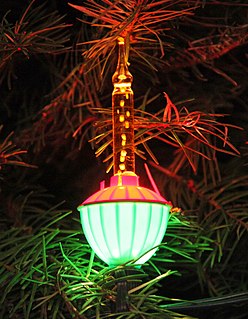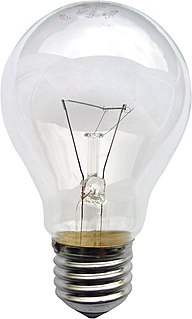Related Research Articles

An incandescent light bulb, incandescent lamp or incandescent light globe is an electric light with a wire filament heated until it glows. The filament is enclosed in a glass bulb with a vacuum or inert gas to protect the filament from oxidation. Current is supplied to the filament by terminals or wires embedded in the glass. A bulb socket provides mechanical support and electrical connections.

A fluorescent lamp, or fluorescent tube, is a low-pressure mercury-vapor gas-discharge lamp that uses fluorescence to produce visible light. An electric current in the gas excites mercury vapor, which produces short-wave ultraviolet light that then causes a phosphor coating on the inside of the lamp to glow. A fluorescent lamp converts electrical energy into useful light much more efficiently than an incandescent lamp. The typical luminous efficacy of fluorescent lighting systems is 50–100 lumens per watt, several times the efficacy of incandescent bulbs with comparable light output. For comparison, the luminous efficacy of an incandescent bulb may only be 16 lumens per watt.

A flash is a device used in photography that produces a brief burst of light at a color temperature of about 5500 K to help illuminate a scene. A major purpose of a flash is to illuminate a dark scene. Other uses are capturing quickly moving objects or changing the quality of light. Flash refers either to the flash of light itself or to the electronic flash unit discharging the light. Most current flash units are electronic, having evolved from single-use flashbulbs and flammable powders. Modern cameras often activate flash units automatically.

A flashlight or torch is a portable hand-held electric lamp. Formerly, the light source typically was a miniature incandescent light bulb, but these have been displaced by light-emitting diodes (LEDs) since the mid-2000s. A typical flashlight consists of the light source mounted in a reflector, a transparent cover to protect the light source and reflector, a battery, and a switch, all enclosed in a case.

The Trimline telephone is a series of telephones produced by Western Electric, the manufacturing unit of the Bell System, and first introduced in 1965. It was designed by Henry Dreyfuss Associates under the project direction of Donald Genaro; the firm had designed all previous desktop telephone models for the American Telephone & Telegraph conglomerate.

A headlamp is a lamp attached to the front of a vehicle to illuminate the road ahead. Headlamps are also often called headlights, but in the most precise usage, headlamp is the term for the device itself and headlight is the term for the beam of light produced and distributed by the device.
An antifuse is an electrical device that performs the opposite function to a fuse. Whereas a fuse starts with a low resistance and is designed to permanently break an electrically conductive path, an antifuse starts with a high resistance, and programming it converts it into a permanent electrically conductive path. This technology has many applications.

A compact fluorescent lamp (CFL), also called compact fluorescent light, energy-saving light and compact fluorescent tube, is a fluorescent lamp designed to replace an incandescent light bulb; some types fit into light fixtures designed for incandescent bulbs. The lamps use a tube that is curved or folded to fit into the space of an incandescent bulb, and a compact electronic ballast in the base of the lamp.

A daytime running lamp is an automotive lighting and bicycle lighting device on the front of a roadgoing motor vehicle or bicycle, automatically switched on when the vehicle's handbrake has been pulled down, when the vehicle is in gear, or when the engine is started, emitting white, yellow, or amber light. Their intended use is not to help the driver see the road or their surroundings, but to help other road users identify an active vehicle.

The lighting system of a motor vehicle consists of lighting and signalling devices mounted or integrated at the front, rear, sides, and in some cases the top of a motor vehicle. They illuminate the roadway ahead for the driver and increase the vehicle's visibility, allowing other drivers and pedestrians to see its presence, position, size, and direction of travel, and its driver's intentions. Emergency vehicles usually have distinctive lighting equipment to warn drivers and indicate priority of movement in traffic.

A bubble light is a decorative device consisting of a liquid-filled vial that is heated and illuminated by an incandescent light bulb. Because of the liquid's low boiling point, 39.6°C (103.3°F), the modest heat generated by the lamp causes the liquid to boil and bubble up from the vial's base thus creating a decorative effect.

A parabolic aluminized reflector lamp is a type of electric lamp that is widely used in commercial, residential, and transportation illumination. It produces a highly directional beam. Usage includes theatrical lighting, locomotive headlamps, aircraft landing lights, and residential and commercial recessed lights.

A deuterium arc lamp is a low-pressure gas-discharge light source often used in spectroscopy when a continuous spectrum in the ultraviolet region is needed.

Edison screw (ES) is a standard lightbulb socket for electric light bulbs. It was developed by Thomas Edison, patented in 1881, and was licensed in 1909 under General Electric's Mazda trademark. The bulbs have right-hand threaded metal bases (caps) which screw into matching threaded sockets. For bulbs powered by AC current, the thread is generally connected to neutral and the contact on the bottom tip of the base is connected to the "live" phase.

Tizio is a desk lamp created by Richard Sapper for Artemide in 1972. It was selected for the Compasso d'Oro industrial design award in 1979. An item of it is part of the collections of the Metropolitan Museum of Art and of the Museum of Modern Art.

A multifaceted reflector light bulb is a reflector housing format for halogen as well as some LED and fluorescent lamps. MR lamps were originally designed for use in slide projectors, but see use in residential lighting and retail lighting as well. They are suited to applications that require directional lighting such as track lighting, recessed ceiling lights, desk lamps, pendant fixtures, landscape lighting, retail display lighting, and bicycle headlights. MR lamps are designated by symbols such as MR16 where the diameter is represented by numerals indicating units of eighths of an inch. Common sizes for general lighting are MR16 and MR11, with MR20 and MR8 used in specialty applications. Many run on low voltage rather than mains voltage alternating current so require a power supply.
The H1 is a halogen lamp designed for use in automotive headlamps and fog and driving lamps. It has also been widely applied in emergency vehicle lights.
Holiday lighting technology has been subject to considerable development and variation since the replacement of candles by electric lights. While originally used during the Christmas holidays as Christmas lights, modern electric light arrays have become popular around the world in many cultures and are used both during religious festivals and for other purposes unconnected to any festivities.

A Tensor lamp is a trademarked brand of small high-intensity low-voltage desk lamp invented by Jay Monroe. The lamp was mainly popular during the 1960s and 1970s. The lamp was originally used by doctors and dentists, and later became more widely used. Although the first prototype was created in 1959, the lamp was not made available to public until 1960. The brand was manufactured by the Tensor Corporation.
References
- ↑ https://tmsearch.uspto.gov/bin/showfield?f=doc&state=4802:z1xxou.3.1 [ dead link ]
- 1 2 3 "1960s Lampette Telescopic Table Lamp". Vintageinfo. March 14, 2019.
- 1 2 3 4 5 "Those little high-intensity lamps". Kiplinger's Personal Finance. June 12, 1965. pp. 35–36 – via Google Books.
- ↑ Reif, Rita (March 21, 1964). "Interest in Tiny Lamps Rises; Designs Multiply for Devices Offering Intense Light" . New York Times . p. 17. ProQuest 115722599.
- ↑ "Koch Creations, Lynbrook, NY. Lampette Reading Lamp (model E6). 1963 | MoMA". The Museum of Modern Art.